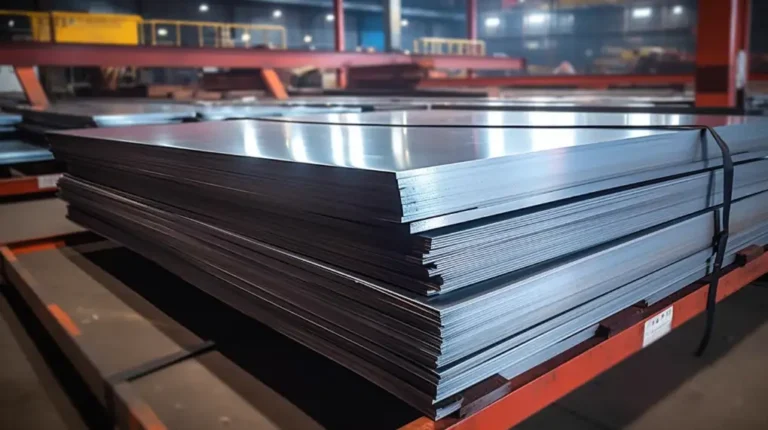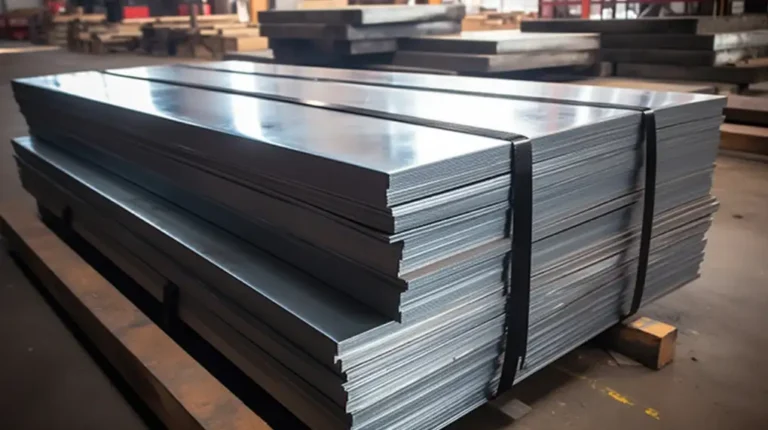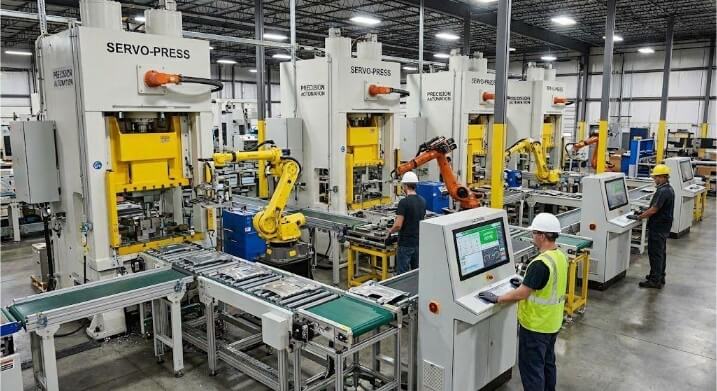Are you looking for a reliable, versatile steel for your projects? Q235 steel might be the answer. Its excellent weldability and cost-effectiveness make it a popular choice in various industries. In this post, I’ll delve into the properties, uses, and comparisons of Q235 steel to help you decide if it meets your needs.
Q235 steel is a Chinese standard carbon structural steel. It is known for its good performance in tensile strength, yield strength, and elongation. This steel grade is widely used because it is easy to weld, cut, and machine, making it ideal for construction and manufacturing.
Now that you have a basic idea of what Q235 steel is let’s explore its properties in more detail.

What is Q235 Steel?
Definition and Basic Properties
Q235 steel is a Chinese standard carbon structural steel. Known for its excellent balance of strength and flexibility, it is widely used in construction and manufacturing. Q235 steel is easy to weld, cut, and machine, making it ideal for various applications. Its name is derived from its yield strength of 235 MPa, indicating its mechanical performance.
Chemical Composition
The chemical composition of Q235 steel ensures its versatile properties. It typically contains:
- Carbon (C): 0.14-0.22%
- Silicon (Si): ≤0.35%
- Manganese (Mn): 0.30-0.70%
- Phosphorus (P): ≤0.045%
- Sulfur (S): ≤0.045%
These elements work together to give the steel strength, toughness, and weldability.
Mechanical Properties
Q235 steel exhibits several critical mechanical properties that make it a popular choice:
- Yield Strength: 235 MPa
- Tensile Strength: 370-500 MPa
- Elongation: 20-26% depending on the thickness
Production Process
Raw Materials Used
The production of Q235 steel begins with selecting high-quality raw materials. The primary materials include:
- Iron ore
- Carbon (from coal or coke)
- Limestone (for removing impurities)
- Alloying elements such as silicon, manganese, phosphorus, and sulfur
These raw materials ensure the final product meets the required strength, flexibility, and weldability standards.
Steps in the Manufacturing Process
- Melting: The raw materials are melted in a blast furnace to produce molten iron. This molten iron contains various impurities that need to be removed.
- Refining: The molten iron is then transferred to a basic oxygen furnace (BOF) or electric arc furnace (EAF) for refining. In this step, oxygen is blown through the molten iron to remove excess carbon and other impurities.
- Alloying: Specific amounts of alloying elements (silicon, manganese, etc.) are added to the refined molten steel to achieve the desired chemical composition of Q235 steel.
- Casting: The molten steel is poured into molds to form ingots, slabs, or billets.
- Hot Rolling: The ingots, slabs, or billets are heated and passed through rollers to reduce their thickness and shape them into the desired forms.
- Cold Rolling: For specific applications, the hot-rolled steel may undergo cold rolling to improve its surface finish and mechanical properties.
Finishing and Treatments
- Heat Treatment: Depending on the application, Q235 steel may undergo various heat treatments to enhance its mechanical properties.
- Surface Treatment: To improve corrosion resistance and surface appearance, the steel may receive surface treatments such as galvanizing, painting, or coating.
- Inspection and Quality Control: The finished steel products undergo rigorous inspection and testing to meet the required standards and specifications.
Types of Q235 Carbon Steel Grade
Q235A
Specific Properties
Q235A is the basic version of Q235 steel. It features:
- Good weldability and formability
- Yield strength: 235 MPa
- Tensile strength: 370-500 MPa
- Elongation: around 26%
Typical Applications
Q235A is commonly used in general construction and engineering projects, such as:
- Building frames
- Bridges
- Structural beams
- General Fabrication
Q235B
Differences from Q235A
Q235B is higher than Q235A and has slightly better mechanical properties. The differences include:
- Improved toughness
- Better weldability
- Slightly higher tensile strength and elongation
Where it is Used
Due to its enhanced properties, Q235B is often used in more demanding structural applications, such as:
- Heavy-duty construction projects
- Machinery parts
- Automotive components
- Large steel structures
Q235C and Q235D
Unique Characteristics
Q235C and Q235D are graded with enhanced performance, particularly in low-temperature environments. They feature:
- Improved impact resistance at low temperatures
- Yield strength: 235 MPa
- Tensile strength: 370-500 MPa
- Elongation: 20-23%, depending on the specific grade
Industrial Applications
These grades are suited for applications requiring better toughness and durability, such as:
- Offshore structures
- Cold storage facilities
- Bridges in colder climates
- High-stress structural components
Q235 Carbon Steel Grade Comparison
Q235 steel comes in several grades, each with specific chemical compositions that affect their properties and applications. Here is a detailed comparison of the different grades of Q235 steel:
| Steel Grade | Carbon (C %) | Silicon (Si %) | Manganese (Mn %) | Phosphorus (P %) | Sulfur (S %) |
|---|---|---|---|---|---|
| Q235A | 0.22 | 0.35 | 1.4 | 0.045 | 0.05 |
| Q235B | 0.2 | 0.35 | 1.4 | 0.045 | 0.045 |
| Q235C | 0.17 | 0.35 | 1.4 | 0.04 | 0.04 |
| Q235D | 0.17 | 0.35 | 1.4 | 0.035 | 0.035 |
Quality Grade: A ≤ B < C < D
The quality of Q235 steel improves from grade A to grade D. This progression is indicated by a decrease in the maximum allowable percentages of carbon (C), phosphorus (P), and sulfur (S). Lower carbon content generally enhances flexibility, while reduced phosphorus and sulfur contents improve the steel’s toughness and weldability.
Comparison with Other Steels
Q235 vs. A36
Property Comparison
- Yield Strength: Q235 and A36 have a similar yield strength of approximately 235 MPa.
- Tensile Strength: Q235 has a tensile strength range of 370-500 MPa, while A36 ranges from 400-550 MPa.
- Composition: Q235 typically contains slightly higher amounts of silicon and manganese than A36.
Application Differences
- Q235: Preferred for its excellent weldability and cost-effectiveness, commonly used in general construction, structural elements, and machine parts manufacturing.
- A36: Widely used in structural applications in the US, such as building frames, bridges, and oil rigs, due to its slightly higher tensile strength and greater availability in the American market.
Q235 vs. Other Common Steels (S235, SS400)
Strengths and Weaknesses
- Q235 vs. S235: Both have similar yield strengths around 235 MPa. S235, following the European standard, is very similar to Q235 in mechanical properties but might have slightly different chemical compositions, resulting in minor differences in performance.
- Q235 vs. SS400: SS400 is a Japanese standard steel with mechanical properties similar to Q235, including yield and tensile strength. SS400 is known for its good weldability and machinability, making it comparable to Q235.
Cost-Effectiveness
- Q235: Generally considered very cost-effective due to its widespread availability and good balance of properties. It’s a popular choice for projects that require reliable performance at a lower cost.
- S235: Slightly more expensive than Q235 due to different production standards and material costs in Europe.
- SS400: Cost-effective like Q235, particularly in the Asian markets, with a slight price variation depending on regional availability and manufacturing processes.
Properties in Detail
Tensile Strength
Tensile strength refers to the maximum stress Q235 steel can withstand while stretched or pulled before breaking. For Q235 steel, the tensile strength ranges between 375 and 500 MPa. This property makes Q235 steel suitable for applications requiring high strength and durability.
Yield Strength
Yield strength is the stress at which Q235 steel begins to deform plastically. Beyond this point, the material will not return to its original shape. Q235 steel has a yield strength of 235 MPa. This balance of strength and flexibility allows for its use in construction and structural applications.
Elongation and Ductility
Elongation measures the ability of Q235 steel to stretch before breaking, expressed as a percentage of its original length. Q235 steel typically has an elongation of 20-26%. This high ductility means Q235 steel can quickly form into different shapes without cracking, making it ideal for various manufacturing processes.
Hardness
Hardness indicates the resistance of Q235 steel to deformation and wear. While Q235 is not as hard as some other steels, it offers sufficient hardness for many practical applications. The Brinell hardness of Q235 steel is typically around 100-130 HB. This moderate hardness ensures good machinability and workability while providing adequate wear resistance for many uses.
Applications of Q235 Carbon Steel
Construction Industry
- Structural beams and columns
- Bridges
- Building frames
- Reinforcing bars
- Purlins and roofing structures
- Scaffolding
- Railway tracks
Machinery and Automotive
- Machine frames and parts
- Chassis components
- Automotive frames and panels
- Gearboxes and engine components
- Agricultural machinery
Others (Furniture, Equipment)
- Metal furniture frames
- Shelving units
- Storage racks
- Kitchen equipment
- Industrial racks and storage solutions
- Tool cabinets and workbenches
- Office desks and chairs

Advantages of Using Q235 Steel
Cost Benefits
Q235 steel is highly cost-effective. Its lower production costs and widespread availability make it an affordable option for various projects. This cost efficiency does not compromise quality, making it a popular choice for budget-conscious applications without sacrificing performance.
Availability and Sourcing
Q235 steel is readily available in the market. Its popularity ensures a consistent supply, which reduces lead times and simplifies sourcing. Manufacturers and suppliers worldwide stock Q235 steel, making it accessible for international projects and ensuring timely delivery.
Versatility in Applications
Q235 steel’s excellent mechanical properties, such as good weldability, flexibility, and strength, make it highly versatile. It suits various applications, including construction, machinery, automotive, and everyday items.
Limitations and Challenges
Limitations in Use
While Q235 steel is versatile and cost-effective, it has some limitations:
- Corrosion Resistance: Q235 steel has moderate corrosion resistance, which may not be sufficient for highly corrosive environments. It often requires additional protective coatings or treatments.
- Strength Limitations: Compared to high-strength steels, Q235 has lower tensile and yield strength, limiting its use in applications requiring extremely high strength.
- Temperature Sensitivity: Q235 steel’s performance can degrade at very high or low temperatures, making it less suitable for extreme temperatures.
Common Problems and How to Overcome Them
- Corrosion: To combat corrosion, apply protective coatings such as galvanizing, painting, or anti-corrosive treatments. Regular maintenance and inspections can also help detect and address corrosion early.
- Welding Issues: Ensure proper welding techniques and equipment are used to avoid weld defects. Preheating the steel before welding and using appropriate welding rods can improve weld quality.
- Machining Challenges: When machining Q235 steel, sharp tools, and proper cutting speeds are used to avoid work hardening and tool wear. Cooling fluids can also help reduce heat buildup and extend tool life.
- Deformation: Controlled cooling methods prevent deformation during processing and prevent rapid quenching. Properly supporting the steel during fabrication can also minimize warping and bending.
Conclusion
Q235 steel is a versatile, cost-effective material widely used in various industries due to its excellent mechanical properties, good weldability, and ease of machining. It finds applications in construction, machinery, automotive, and everyday items. While it has limitations in corrosion resistance and strength compared to high-strength steels, proper treatments and precautions can mitigate these challenges.
Do you need a reliable sheet metal parts manufacturer? Shengen is the place to go. We specialize in sheet metal laser cutting, bending, surface finish, and CNC Machining. Reach out to Shengen Today and seek help from professionals!
FAQs
What is Q235 Equivalent To?
Q235 steel is equivalent to several international standards, including:
- A36 (American standard)
- S235 (European standard)
- SS400 (Japanese standard)
These steels have similar mechanical properties and are often used interchangeably in various applications.
How Does the Cost of Q235 Steel Compare to Other Steels?
Q235 steel is generally more cost-effective than many other steel grades. Its widespread availability and lower production costs make it an economical choice for various projects. While prices can vary based on market conditions and regional factors, Q235 typically offers a good balance of cost and performance.
Does Q235 Rust?
Yes, Q235 steel can rust as it has moderate corrosion resistance. It is often coated with protective layers such as galvanizing, painting, or other anti-corrosive treatments to prevent rusting. Regular maintenance and inspections can also help manage and prevent rust.
Can Q235 Steel Be Used for Outdoor Structures?
Q235 steel can be used for outdoor structures, but proper protective measures are required to prevent corrosion. Coatings like galvanizing or painting are commonly applied to enhance its durability in outdoor environments. With these precautions, Q235 steel can perform well in outdoor applications.
More Resources:
Differences Between Q235 and SS400 – Source: Weldflange
Protective Coatings for Steel – Source: Secoatech
How to Prevent Steel Corrosion – Source: Eoncoat
Hey, I'm Kevin Lee

For the past 10 years, I’ve been immersed in various forms of sheet metal fabrication, sharing cool insights here from my experiences across diverse workshops.
Get in touch

Kevin Lee
I have over ten years of professional experience in sheet metal fabrication, specializing in laser cutting, bending, welding, and surface treatment techniques. As the Technical Director at Shengen, I am committed to solving complex manufacturing challenges and driving innovation and quality in each project.




